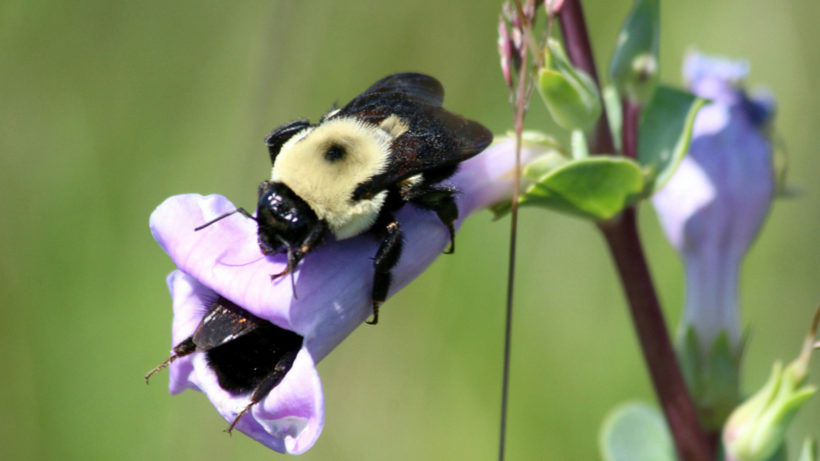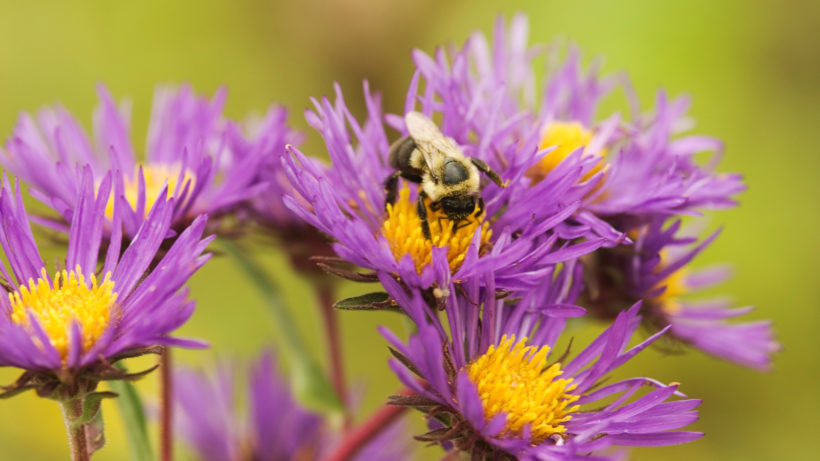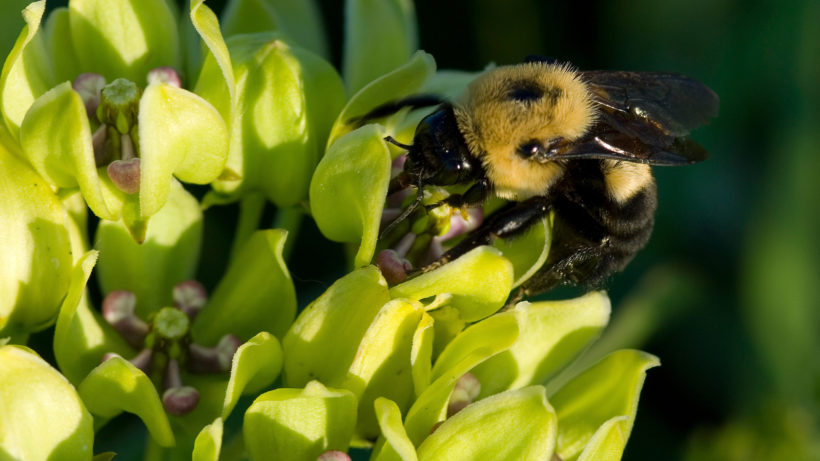You’ve probably heard about the problems facing honey bees across North America, as hives disappear in the face of “colony collapse disorder.” You also undoubtedly know that this loss of pollinators could have severe impacts on food production.
But you may not know this: honey bees get the press, but they’re not the only pollinator in trouble. In fact, native bumble bees have been facing even more alarming declines across the continent.
This loss of bumble bees could have severe consequences for native ecosystems and for agriculture.
Bumble bees are perhaps the most charismatic of all bee species: they’re fuzzy, colorful and non-aggressive. And they’re one of the very few insects to inspire a symphony.
They’re also vital pollinators – more important to ecosystems than the non-native honey bee. Fifty species of North American bumble bees pollinate native plants, which in turn produce flowers and seeds that feed everything from songbirds to grizzly bears.
The Xerces Society, an organization devoted to invertebrate conservation, reports that bumble bees are also the most important pollinators for blueberries, cranberries, clover, greenhouse tomatoes and other crops.
But they’re in decline. According to the Xerces Society:
“At least four species of formerly common North American bumble bees have experienced catastrophic declines over the past decade – two of them may be on the brink of extinction. Preliminary investigations by many scientists indicate that a number of other formerly common species are also less abundant than they were in the past.”
What’s going on here? Is there anything conservationists can do about it?

Where Have All the Pollinators Gone?
An incident in an Oregon parking lot last summer dramatically illustrated the plight faced by native pollinators.
At a mall parking lot in Wilsonville, people began finding dead bumble bees – unbelievable numbers of dead bumble bees. It turned out to be the largest bumble bee die-off ever recorded, with more than 50,000 dead bees littering the area.
A wildlife mystery? Not quite.
It turns out that someone had sprayed 55 flowering trees with a pesticide known as a neonicotinoid, legal for use but deadly for insects, including beneficial ones like pollinators.
How many other times do such die-offs occur, out of sight of people? As the Xerces Society’s executive director Scott Black said in a Grist interview, “If these events had not happened over areas of concrete, I am not sure anyone would have ever noticed. The insects would just fall into the grass to be eaten by birds as well as ants and other insects.”
Oregon has since restricted the use of some neonicotinoid pesticides to protect native pollinators. Currently, on the federal level, Representatives John Conyers (D-MI) and Earl Blumenauer (D-OR) have drafted a bill that will suspend use of the worst neonicotinoid pesticides and direct EPA to perform a deeper evaluation of their impacts on pollinators — Saving America’s Pollinators Act.
In addition to pesticides, bumble bees face a long list of other threats – habitat loss, climate change, competition from non-native bees, introduced diseases.
According to the Xerces Society, habitat loss in particular is having a profound effect on bumble bees (and other native pollinators).
Bumble bees need a mix of native plants to feed on as well as grassy areas to burrow. They once found this habitat in plenty on the edges of farms and yards, and even in roadside ditches. But there has been a tendency to “clean up” – to remove the wilder edges around human development.
That’s bad for bees and other pollinators.
A neatly trimmed grass lawn may be green but it’s not green – especially if it is sprayed with pesticides and all native plants are removed.
We often think of habitat loss as an irreversible problem, or one that can be solved only by intensive restoration activities. If a subdivision goes in and takes out part of a wolverine’s range, it is not like you can plant a few trees and bring back wolverines.
But with bumble bees, you can reverse habitat loss. Yards, ditches and abandoned lots can make a big difference. Your personal actions can native pollinators – protecting not only cool critters but also vital ecosystem services.

How You Can Be Bee Friendly
Bumble bees live across North America, Europe and Asia in a wide variety of habitats and climates. Adding some flowering plants to your yard will add some variety to the neighborhood, and also benefit bumble bees.
The Xerces Society gets you started with a complete guide to home gardening for bumble bees. Ideally, you can add a mix of flowering plants that bloom in the spring, summer and fall – providing a more year-round food source.
There’s a great satisfaction in creating your own wildlife haven, and it is probably easier than you think.
My wife Jennifer, who runs the agriculture program for the Northwest Center for Alternatives to Pesticides, tore out our front yard nine years ago and replaced it with drought-tolerant and native high desert plants (appropriate for our arid environment in Boise, Idaho).
Admittedly, the neighbors expressed some consternation when we tore out a “perfectly good lawn.”
We don’t hear those complaints any more, as the yard is alive with beautiful wildflowers, waving tall grasses and cover-providing bushes.
We have fence lizards and valley quail and goldfinches and dragonflies. And we have pollinators. Lots of pollinators. Including bumble bees.
Bumble bees are generalists – they don’t key in on a specific flower. They move from species to species, buzzing around our lawn. We can mark spring by when the first bumble bees show up.
But this year, we won’t just be watching them. We’ll be photo-documenting the bees and sending info to researchers. This initiative, Bumble Bee Watch, is one more way you can assist with pollinator conservation.
With 50 species of bumble bees, it can be hard to track population trends. Bumble Bee Watch asks citizen scientists to photograph any bumble bees they see and report them. You can download a handy bumble bee identification guide, and Bumble Bee Watch can help you identify species.
The news about pollinators can often seem grim. But wherever you live, this is definitely a conservation issue where your actions can have a direct influence.
Plant some flowers, watch for bumble bees and lay off the pesticides – you’ll be well on your way to creating your own pollinator preserve!





What to do about lace bugs if not some kind of poison?
Matt – How about a handy ID Guide for Eastern bumble bees?
Hey man, I am not a problem
I have 2 butterfly, bee, hummingbird gardens and no bees. What can be done to get them back? I really miss my little buddies.
Please help.
I have not seen even one bumble bee this year. Even now that the is clover all around and that’s a first.
Thanks for the input on these important insects. I have heard that bumblebee numbers were on the decline similar to that of honeybees and would like some advise on what to do with a bumblebee nest that is established in the middle of my backyard. I live in a residential suburb of Omaha, Ne and 20 years ago I had 2 tree stumps removed and the domes leveled. Those areas are now covered with fescue grass and you can’t really tell there was ever a tree there other than small penetrations through the sod caused from the former trees roots deteriorating. I am sure the bees have found this to be an ideal nesting site due to heat generated by the rotting roots. The nest is at least a year old due to noticing bee activity in that location when mowing the yard last year. At that time they did not seem aggressive so I left them alone believing they would probably not last through the brutally cold winter weather we have. They survived very well and this year there is about a dozen of them patrolling the area in the grass surrounding their nest. I have grandkids and a dog that play in the backyard and sometimes they get close to the nest area. The bees haven’t stung anyone but do seem more aggressive now that there are more of them to defend the nest. I don’t want to destroy them knowing of the benefits they provide but don’t want someone getting stung in my backyard. Can you provide me with any advise to safely remove and relocate the nest members to different location ?
Can we use one of your bumblebee photos in a publication of ours?
Kurt,
The photos are courtesy of Chris Helzer of the Prairie Ecologist blog. You can reach him via his blog, http://prairieecologist.com/
Best,
Matt
I’ve been telling this to people for years. I started gardening in 1993. When doing things like cutting back an overgrown and unsightly catmint, I would have to tell the bees, “Guys, I’m doing this so you’ll get more and better flowers. Now, let me through,” because the catmints were teeming with bumblebees. About 8 years ago, I started to notice a bumblebee here and there that was holding fast inside a flower. When I would poke it to see if it could fly, it would make and angry buzzing sound, but did not fly away. Poking again might result in the bee moving about as if it was drunk or drugged, and it would fall down. There seemed increasingly to be a paralysis in the bumblebees. And they’d just die.
The following year, I’d be happy to see bumblebees return to the garden (though in fewer numbers), but as summer wore on, I’d see the same pattern. Silent bees “stuck” inside flowers, sometimes one leg paralyzed, sometimes an entire side paralyzed and eventual death. And the “healthy” bees don’t seem as vigorous as they once were.
When I first gardened here in the 90s, my mother, who has a phobia about all insects and arachnids, would visit us in summertime and look out the front door saying, “Be careful! Look at all those bees! How can you pull weeds and do all that garden work with all of those bees flying around you? You’re going to get stung!” No matter how many times I told her bumblebees don’t sting, she wouldn’t listen. She wouldn’t even walk around my property to see the landscaping I was doing because of her fear of bees. Now she walks around all the time, never worrying about bees. And last year, my monarch population dropped to 2. The year before I took a video of monarchs and swallowtails surrounding my butterfly bush. The following year, there were only a few skippers. I don’t use pesticides or herbicides, but I notice that as the neighborhood homeowners aged, they became more affluent and had their lawns treated. I see those little orange flags all over the neighborhood now and I’m sure whatever the lawn services are using is sickening and killing all insects.
My husband and I would like to comment on the plight of our poor bees. For years we have been listening about the massive die/offs or, simply, mysterious disappearances of vast number of bees. Yes, pesticides are lethal. We agree. Let’s get rid of these poisons for our own Health, too!
BUT, we have made an interesting observation over the past few years. We purchased a 25 acre+ property near Misery Bay on Manitoulin Island (Ontario). It is not easily accessible….plus it is also TOTALLY OFF THE GRID – THAT IS, no ELECTRICITY AVAILABLE FOR MILES AND MILES AND NO, that is absolutely NO cell phone coverage for miles and miles and miles! AND one of the first things I noticed wandering over the alvars of our land was this constant hummmm – and it was BEES!!! Millions. I didn’t see them at first until I started looking down….
We believe that the insidious electromagnetic waves from cell towers, etc. that infuse our environment play a huge role in the demise of the bee as well as other super-sensitive insects. After all, we ALL are simply electromagnetic energy (if you understand physics); yes, highly organized electromagnetic energy – and there is no doubt that our high tech world will eventually drive us crazy – just like the bees who seek to escape the chaotic noise (that we can’t see, but that is coursing through our bodies every millisecond).
But we just drag out our lounge chairs onto the shore of Lake Huron and watch hundreds of bees, peacefully going about their business within 15 feet of us.
So, why is so little written about cell-tower emissions????
I think we all know. So YOU can walk around with these little elctromagnetic horrors pressed/plugged into your brains. And we’ll just enjoy our bees.
Entomologists like to say that children love insects…and from day one that may be true. Later on MANY, too many, pick up fear from others …they learn to squash the bug…scream and freak… I am certain that insects sense fear and aim to protect themselves.
Stores are full of insecticides, specifically stressing poison/control of ants, bees, wasps, roaches, earwigs…poison is poison. Zap the mosquitos, how many other insects wander into these light traps? (not to mention how it may affect us)…We have legislations now against weed poison why are we still allowing other poisons, feeding our fear… (why perhaps because industry depends on products that sell)
City neighbourhoods fear hives, not in my back yard, my kids play in that park there is a hive get rid of it……Where are the insects to go? We pave over lawns in fact the latest is artificial turf on many home properties, another threat for the earthworms, insects…hmmm…
WE have to go into schools and educate the young…get them before fear hits…help them hold the insects etc…Yes many science centres are doing this opening up the eyes of lucky individuals…yet places like that are expensive and most families can only afford one or two days out a year, lucky the class that goes on a field trip today…Sadly most children learn something at school from teachers that may also exhibit fear and the cycle of “kill the bug continues”
The connection between starvation and agriculture is often in science/ geography classes the association made with drought/ water/climate change. Why not add insects to the home economics class curriculum as well….
The connection of pollinators = fruit + vegetables must be made and stressed just as equally, over and over. Protect your insects! Love the bees! This is no easy task.
Hello everyone,
Here in Pennsylvania the Bees are out, but there is nothing to eat. We have been watching them roll around in the powdered residue from cracked corn in the bird feeder and feed pans for the cattle. There are no flowers out yet because our warm days have been punctuated by snow and 15 degree nights. My friend put out some nectar (humming bird food) but they haven’t shown any interest in that. Is there anything we can put out for them right now that will help?
Hi Jessica–
I am a beekeeper here in Maine, and also the president of my county’s local beekeepers’ group–and a master gardener with our cooperative extension too. I just wanted to point out, that while thre may not yet be flowers available to your local bees–there are likely a number of trees offering nectar and pollen right now in your area. Some of them include maple, willow, locust, alders, dogwood, basswood, and chestnut trees all offer food for bees before the dandelion bloom–which is the first big nectar flow of the season.
If you’re interested you can read more about how you can help native bees on my blog at http://runamukacres.com
Great job. I wonder what impact a pesticide potent enough to kill of that many bumble bees has on me directly let alone through ecosystem damage.
Great post about the bumblebees!
Love to hear more about what the Conservancy is doing to protect pollinator habitat. For example, are you planting milkweed in Texas and the Midwest to help the Monarch butterflies migrate?
Excellent article. Thanks for letting everyone know they can do a little to help our native bees, whether it be through gardening, photographs, buying organic produce, etc. Like BeeSpotter, Wildlife Preservation Canada is also a partner in BumbleBeeWatch.org and has launched a Canadian At-Risk Pollinator Conservation Program which will not only help create native bee habitat, but also does hands on conservation management with pollinators who have suffered severe declines in efforts to prevent their extinction and augment their populations in the wild. It’s great to see increasing public support for this kind of work!!
Great post! The Office for Mathematics, Science & Technology Education (MSTE) at the University of Illinois Urbana-Champaign works with the Entomology department on Bee Spotter, a citizen science initiative to collect data about Illinois’s pollinators. Similar to Bubmble Bee Watch, you can submit Illinois-specific pics here: http://beespotter.mste.illinois.edu/
Hi Sammy,
BeeSpotter is a partner organization on Bumble Bee Watch (www.BumbleBeeWatch.org), so any Illinois photos submitted to the larger project will automatically be transferred to BeeSpotter!
Thanks for posting this!